外研版(2019) 选择性必修第二册 Unit 3 Times Change! Developing ideas Reading 课件(40张ppt)
文档属性
| 名称 | 外研版(2019) 选择性必修第二册 Unit 3 Times Change! Developing ideas Reading 课件(40张ppt) |  | |
| 格式 | zip | ||
| 文件大小 | 21.1MB | ||
| 资源类型 | 教案 | ||
| 版本资源 | 外研版(2019) | ||
| 科目 | 英语 | ||
| 更新时间 | 2022-12-17 18:16:35 | ||
图片预览

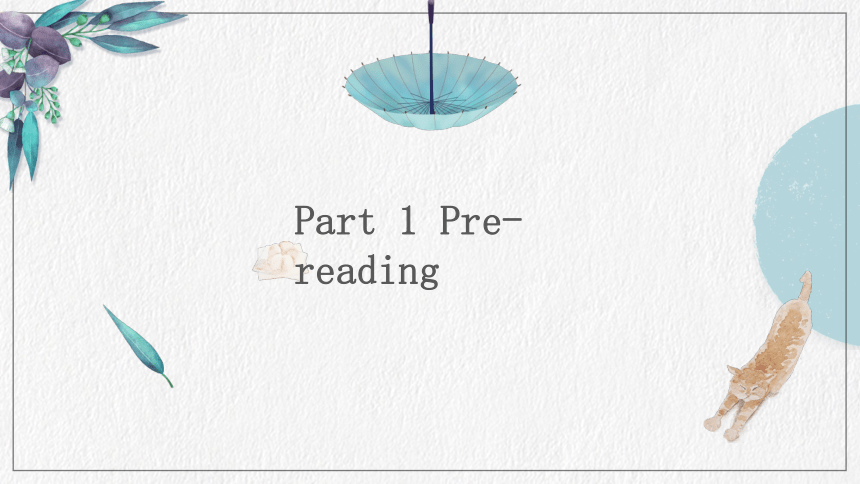


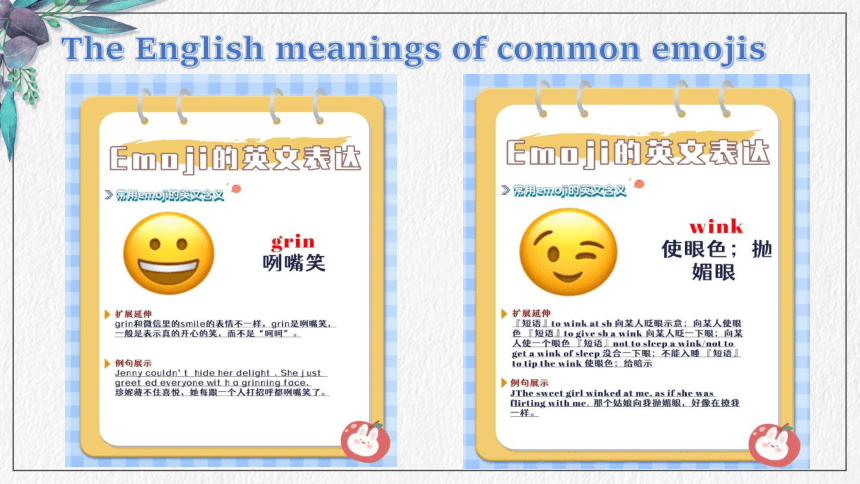
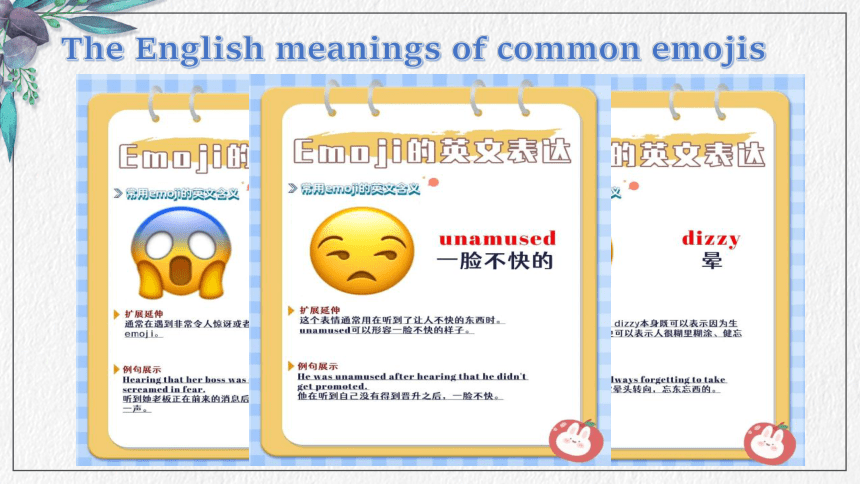
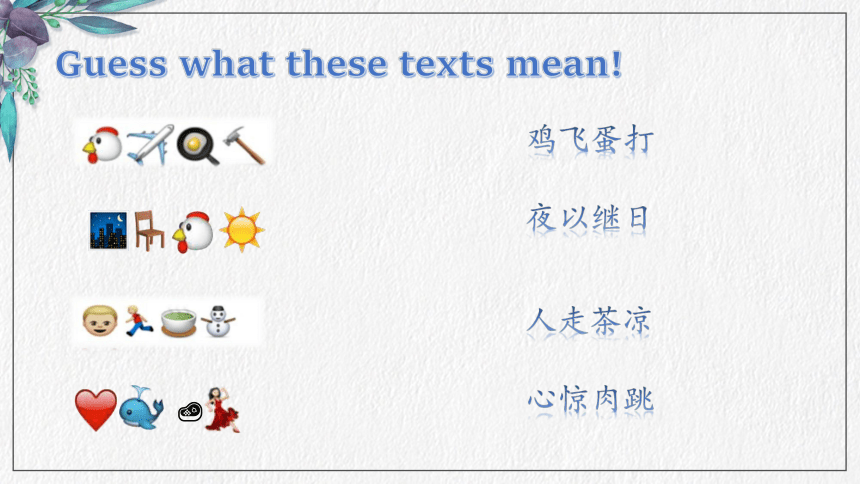
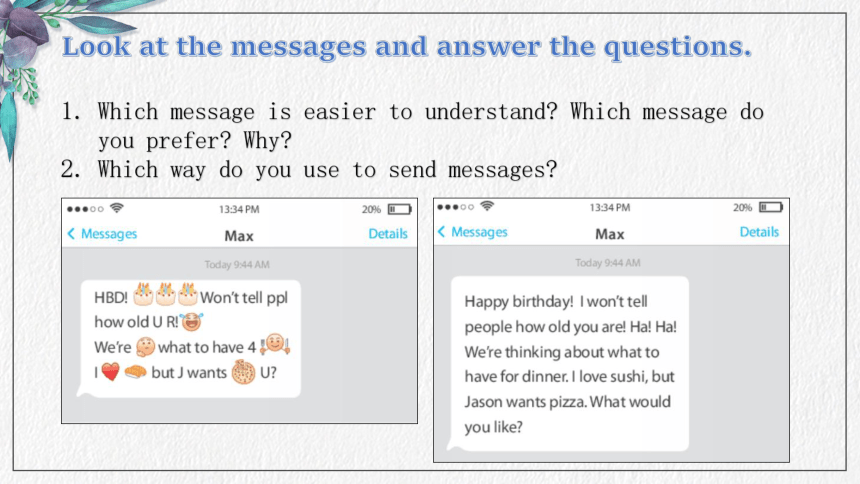
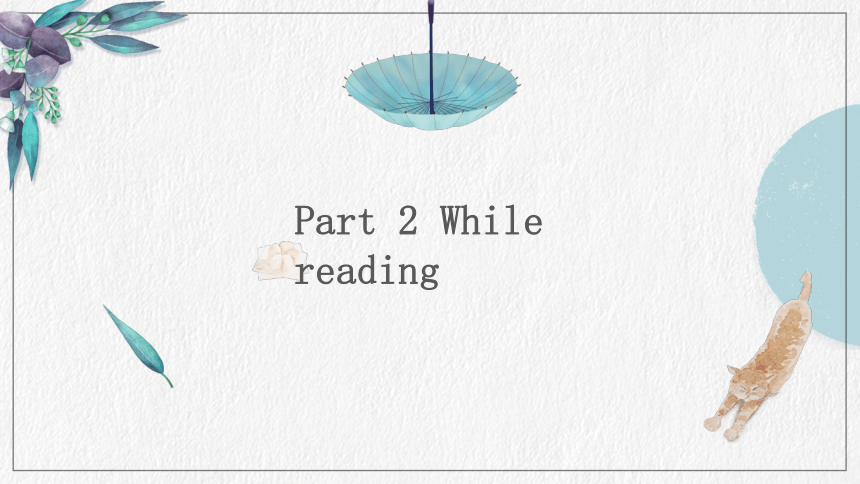

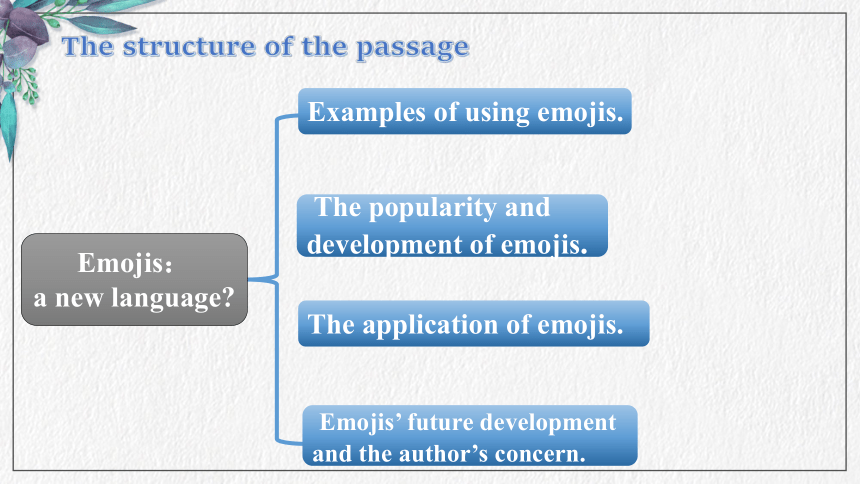
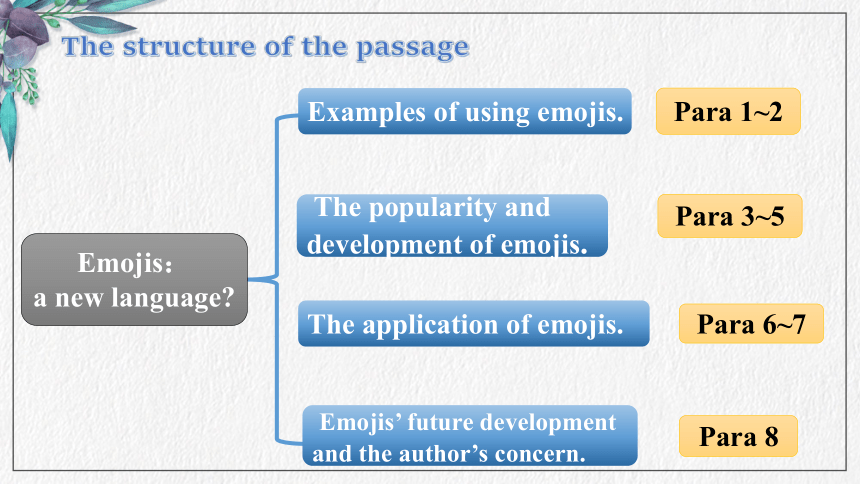
文档简介
(共40张PPT)
Unit 3 Developing ideas(1)
Emojis: a new language
Part 1 Pre-reading
What is emoji
From Japanese 絵文字 (emoji), from 絵 (e, “picture”) + 文字 (moji, “character”)。
A brief history of emoji
The English meanings of common emojis
The English meanings of common emojis
鸡飞蛋打
Guess what these texts mean!
夜以继日
人走茶凉
心惊肉跳
Look at the messages and answer the questions.
Which message is easier to understand Which message do you prefer Why
Which way do you use to send messages
Part 2 While reading
Look at the title of the passage and predict the author’s attitude towards emojis.
The author may be skeptical about emojis as a new language.
The structure of the passage
Emojis:
a new language
Examples of using emojis.
The popularity and development of emojis.
The application of emojis.
Emojis’ future development and the author’s concern.
The structure of the passage
Emojis:
a new language
Examples of using emojis.
The popularity and development of emojis.
The application of emojis.
Emojis’ future development and the author’s concern.
Para 1~2
Para 3~5
Para 6~7
Para 8
Think about the author’s purpose in writing the passage and give your reasons.
1. To guide readers to use emojis properly.
2. To discuss the development and influence of emojis.
3. To criticise the increased use of emojis.
4. To entertain readers with examples of how emojis have been used.
√
Think about the author’s purpose in writing the passage and give your reasons.
1. To guide readers to use emojis properly.
2. To discuss the development and influence of emojis.
3. To criticise the increased use of emojis.
4. To entertain readers with examples of how emojis have been used.
√
The author introduces the topic of emojis through examples, then introduces the origin and development of emojis, and explains the application of emojis in daily life. Finally, the article discusses the future development of emojis.
Thus, we can see from the passage that the author intends to discuss the development and influence of emojis.
What do these emojis mean
“I’d be running late and would be there soon.”
“OK! Don’t rush.”
Para. 1-2
Read and answer
Para. 1-2
Why does the author tell the story between he and his friend
A. To share the fun of using emojis
B. To show the advantages of emojis
C. To warn the inconvenience of emojis
D. To introduce the topic of the article---emojis
√
Read and answer
Para. 2: …Instead of replying with a simple "OK, don’t rush searched for emojis on my phone that would express the same Message:
Para. 3: This was my attempt to follow the trend of communicating with emojis.
Para. 1-2
Why does the author tell the story between he and his friend
A. To share the fun of using emojis
B. To show the advantages of emojis
C. To warn the inconvenience of emojis
D. To introduce the topic of the article---emojis
√
Read and answer
Para. 3
2. How popular emojis are now
A. Using emojis to communicate isn’t common
B. They are an essential part of today’s language
C. They are an impolite way to express ourselves
D. Their development is slow
√
Read and answer
Para. 3: With the rapid development of social media, emojis are becoming an integral component of the language we use to express ourselves.
Para. 3
2. How popular emojis are now
A. Using emojis to communicate isn’t common
B. They are an essential part of today’s language
C. They are an impolite way to express ourselves
D. Their development is slow
√
Read and answer
Para. 4: The word “emoji” comes from Japanese, literally meaning “picture character”. Emojis are small symbols representing ideas, emotions or feelings. They come in different categories, such as faces and people, plants and animals, and food and drink.
Para. 4
3. What does the word "emoji" come from
Read and answer
Para. 5
4. Why do the writer mention the Oxford Dictionaries Word of the year here
A. To show the popularity of emojis
B. To introduce the authority(权威) of the Oxford Dictionaries
C. To tell the government’ support for emojis
D. To stress the importance of emojis
√
Read and answer
Para. 5: Due to their popularity, the Oxford Dictionaries Word of the Year in 2015 was for the first time ever, a pictograph instead of a traditional word.
Para. 5
4. Why do the writer mention the Oxford Dictionaries Word of the year here
A. To show the popularity of emojis
B. To introduce the authority(权威) of the Oxford Dictionaries
C. To tell the government’ support for emojis
D. To stress the importance of emojis
√
Read and answer
Para. 6: People like them because they add emotional meaning, and are quick and easy to use;
Emojis can also help people express their feelings when they cannot find the appropriate words.
Para. 6
5. Why do people like emojis so much
Read and answer
Para. 7: The application
The use of emojis has even spread to classical literature.
For example: A Shakespeare series for young readers has taken William Shakespeare`s popular plays and replaced some words with textspeak and emojis.
What is the advantage
What is the disadvantage
Read and answer
Para. 7: The application
The use of emojis has even spread to classical literature.
For example: A Shakespeare series for young readers has taken William Shakespeare`s popular plays and replaced some words with textspeak and emojis.
What is the advantage
What is the disadvantage
The intention of these adaptations is to make the classics more accessible to young readers.
These new versions have taken away the heart and soul of Shakespeare`s plays.
Read and answer
Para. 8: The future
7. Which of the following is NOT a reason why educators are worried about the use of emojis
A. Because we may not be able to communicate by language one day
B. Because people prefer emojis to written and spoken words
C. Because people probably will completely rely on the pictorial language to communicate
D. Because emojis are easier to understand than written words
√
Read and answer
Para. 8: But this makes others especially educators, worry that we are losing the ability to communicate properly using the written word, or even the spoken word. After all, how many of us today would rather send a message packed with emojis than make a telephone call Perhaps people will one day choose to communicate in pictures and forget how to write properly.
Para. 8: The future
7. Which of the following is NOT a reason why educators are worried about the use of emojis
A. Because we may not be able to communicate by language one day
B. Because people prefer emojis to written and spoken words
C. Because people probably will completely rely on the pictorial language to communicate
D. Because emojis are easier to understand than written words
√
Part 3 Post-reading
Think& Share
Q1. Do you think the Shakespeare series with emojis is an effective way to encourage young readers to read the classics Give your reasons.
Think& Share
Q1. Do you think the Shakespeare series with emojis is an effective way to encourage young readers to read the classics Give your reasons.
Possible answer:
NO: I don't think so. Just as many people say, these new versions of Shakespeare series have taken away the heart and soul of the classic plays.
YES: Yes. I think it can make the classics more accessible to us young readers.
Think& Share
Q2. What do you think about the way people use emojis
Think& Share
Q2. What do you think about the way people use emojis
Possible answer:
Emojis occasionally used in daily conversation are really vivid and interesting in conveying our feelings.
But if we only use emojis to communicate, it sometimes may be very hard for us to understand and it is also a waste of time spending so much time finding proper emojis to express one’s feelings.
Think& Share
Q3. What lifestyle changes does each reading passage in this unit focus on What is the common message conveyed in both passages
Think& Share
Q3. What lifestyle changes does each reading passage in this unit focus on What is the common message conveyed in both passages
Possible answer:
The first passage focuses on changes of people’s reading habits, while the second passage focuses on changes of the way we communicate. Both passages convey changes of our lives and society in which we live.
Group work
Work in groups. Give a talk about the sentence from the passage
“Perhaps people will one day choose to communicate in pictures, and forget how to write properly.” (P44)
Group work
Work in groups. Give a talk about the sentence from the passage
“Perhaps people will one day choose to communicate in pictures, and forget how to write properly.” (P44)
Read this sentence and decide whether you agree or disagree with it.
Provide three reasons to support your ideas and give evidence for each reason.
Group work
Reasons Evidence
… …
I disagree. Because …
Group work
Reasons Evidence
… …
I disagree. Because …
Emojis can only express a very limited amount of meaning.
The emoji that illustrates two folded hands.
Emojis can be confusing when using them.
Writing allows us to communicate abstract concepts.
Group work
I disagree. Because …
Learning to learn
When you give your opinion, your argument will be stronger if it is supported by evidence.
Evidence can come from primary sources, such as original documents and interviews, or secondary sources, such as books and magazines.
THANK YOU!
Unit 3 Developing ideas(1)
Emojis: a new language
Part 1 Pre-reading
What is emoji
From Japanese 絵文字 (emoji), from 絵 (e, “picture”) + 文字 (moji, “character”)。
A brief history of emoji
The English meanings of common emojis
The English meanings of common emojis
鸡飞蛋打
Guess what these texts mean!
夜以继日
人走茶凉
心惊肉跳
Look at the messages and answer the questions.
Which message is easier to understand Which message do you prefer Why
Which way do you use to send messages
Part 2 While reading
Look at the title of the passage and predict the author’s attitude towards emojis.
The author may be skeptical about emojis as a new language.
The structure of the passage
Emojis:
a new language
Examples of using emojis.
The popularity and development of emojis.
The application of emojis.
Emojis’ future development and the author’s concern.
The structure of the passage
Emojis:
a new language
Examples of using emojis.
The popularity and development of emojis.
The application of emojis.
Emojis’ future development and the author’s concern.
Para 1~2
Para 3~5
Para 6~7
Para 8
Think about the author’s purpose in writing the passage and give your reasons.
1. To guide readers to use emojis properly.
2. To discuss the development and influence of emojis.
3. To criticise the increased use of emojis.
4. To entertain readers with examples of how emojis have been used.
√
Think about the author’s purpose in writing the passage and give your reasons.
1. To guide readers to use emojis properly.
2. To discuss the development and influence of emojis.
3. To criticise the increased use of emojis.
4. To entertain readers with examples of how emojis have been used.
√
The author introduces the topic of emojis through examples, then introduces the origin and development of emojis, and explains the application of emojis in daily life. Finally, the article discusses the future development of emojis.
Thus, we can see from the passage that the author intends to discuss the development and influence of emojis.
What do these emojis mean
“I’d be running late and would be there soon.”
“OK! Don’t rush.”
Para. 1-2
Read and answer
Para. 1-2
Why does the author tell the story between he and his friend
A. To share the fun of using emojis
B. To show the advantages of emojis
C. To warn the inconvenience of emojis
D. To introduce the topic of the article---emojis
√
Read and answer
Para. 2: …Instead of replying with a simple "OK, don’t rush searched for emojis on my phone that would express the same Message:
Para. 3: This was my attempt to follow the trend of communicating with emojis.
Para. 1-2
Why does the author tell the story between he and his friend
A. To share the fun of using emojis
B. To show the advantages of emojis
C. To warn the inconvenience of emojis
D. To introduce the topic of the article---emojis
√
Read and answer
Para. 3
2. How popular emojis are now
A. Using emojis to communicate isn’t common
B. They are an essential part of today’s language
C. They are an impolite way to express ourselves
D. Their development is slow
√
Read and answer
Para. 3: With the rapid development of social media, emojis are becoming an integral component of the language we use to express ourselves.
Para. 3
2. How popular emojis are now
A. Using emojis to communicate isn’t common
B. They are an essential part of today’s language
C. They are an impolite way to express ourselves
D. Their development is slow
√
Read and answer
Para. 4: The word “emoji” comes from Japanese, literally meaning “picture character”. Emojis are small symbols representing ideas, emotions or feelings. They come in different categories, such as faces and people, plants and animals, and food and drink.
Para. 4
3. What does the word "emoji" come from
Read and answer
Para. 5
4. Why do the writer mention the Oxford Dictionaries Word of the year here
A. To show the popularity of emojis
B. To introduce the authority(权威) of the Oxford Dictionaries
C. To tell the government’ support for emojis
D. To stress the importance of emojis
√
Read and answer
Para. 5: Due to their popularity, the Oxford Dictionaries Word of the Year in 2015 was for the first time ever, a pictograph instead of a traditional word.
Para. 5
4. Why do the writer mention the Oxford Dictionaries Word of the year here
A. To show the popularity of emojis
B. To introduce the authority(权威) of the Oxford Dictionaries
C. To tell the government’ support for emojis
D. To stress the importance of emojis
√
Read and answer
Para. 6: People like them because they add emotional meaning, and are quick and easy to use;
Emojis can also help people express their feelings when they cannot find the appropriate words.
Para. 6
5. Why do people like emojis so much
Read and answer
Para. 7: The application
The use of emojis has even spread to classical literature.
For example: A Shakespeare series for young readers has taken William Shakespeare`s popular plays and replaced some words with textspeak and emojis.
What is the advantage
What is the disadvantage
Read and answer
Para. 7: The application
The use of emojis has even spread to classical literature.
For example: A Shakespeare series for young readers has taken William Shakespeare`s popular plays and replaced some words with textspeak and emojis.
What is the advantage
What is the disadvantage
The intention of these adaptations is to make the classics more accessible to young readers.
These new versions have taken away the heart and soul of Shakespeare`s plays.
Read and answer
Para. 8: The future
7. Which of the following is NOT a reason why educators are worried about the use of emojis
A. Because we may not be able to communicate by language one day
B. Because people prefer emojis to written and spoken words
C. Because people probably will completely rely on the pictorial language to communicate
D. Because emojis are easier to understand than written words
√
Read and answer
Para. 8: But this makes others especially educators, worry that we are losing the ability to communicate properly using the written word, or even the spoken word. After all, how many of us today would rather send a message packed with emojis than make a telephone call Perhaps people will one day choose to communicate in pictures and forget how to write properly.
Para. 8: The future
7. Which of the following is NOT a reason why educators are worried about the use of emojis
A. Because we may not be able to communicate by language one day
B. Because people prefer emojis to written and spoken words
C. Because people probably will completely rely on the pictorial language to communicate
D. Because emojis are easier to understand than written words
√
Part 3 Post-reading
Think& Share
Q1. Do you think the Shakespeare series with emojis is an effective way to encourage young readers to read the classics Give your reasons.
Think& Share
Q1. Do you think the Shakespeare series with emojis is an effective way to encourage young readers to read the classics Give your reasons.
Possible answer:
NO: I don't think so. Just as many people say, these new versions of Shakespeare series have taken away the heart and soul of the classic plays.
YES: Yes. I think it can make the classics more accessible to us young readers.
Think& Share
Q2. What do you think about the way people use emojis
Think& Share
Q2. What do you think about the way people use emojis
Possible answer:
Emojis occasionally used in daily conversation are really vivid and interesting in conveying our feelings.
But if we only use emojis to communicate, it sometimes may be very hard for us to understand and it is also a waste of time spending so much time finding proper emojis to express one’s feelings.
Think& Share
Q3. What lifestyle changes does each reading passage in this unit focus on What is the common message conveyed in both passages
Think& Share
Q3. What lifestyle changes does each reading passage in this unit focus on What is the common message conveyed in both passages
Possible answer:
The first passage focuses on changes of people’s reading habits, while the second passage focuses on changes of the way we communicate. Both passages convey changes of our lives and society in which we live.
Group work
Work in groups. Give a talk about the sentence from the passage
“Perhaps people will one day choose to communicate in pictures, and forget how to write properly.” (P44)
Group work
Work in groups. Give a talk about the sentence from the passage
“Perhaps people will one day choose to communicate in pictures, and forget how to write properly.” (P44)
Read this sentence and decide whether you agree or disagree with it.
Provide three reasons to support your ideas and give evidence for each reason.
Group work
Reasons Evidence
… …
I disagree. Because …
Group work
Reasons Evidence
… …
I disagree. Because …
Emojis can only express a very limited amount of meaning.
The emoji that illustrates two folded hands.
Emojis can be confusing when using them.
Writing allows us to communicate abstract concepts.
Group work
I disagree. Because …
Learning to learn
When you give your opinion, your argument will be stronger if it is supported by evidence.
Evidence can come from primary sources, such as original documents and interviews, or secondary sources, such as books and magazines.
THANK YOU!
